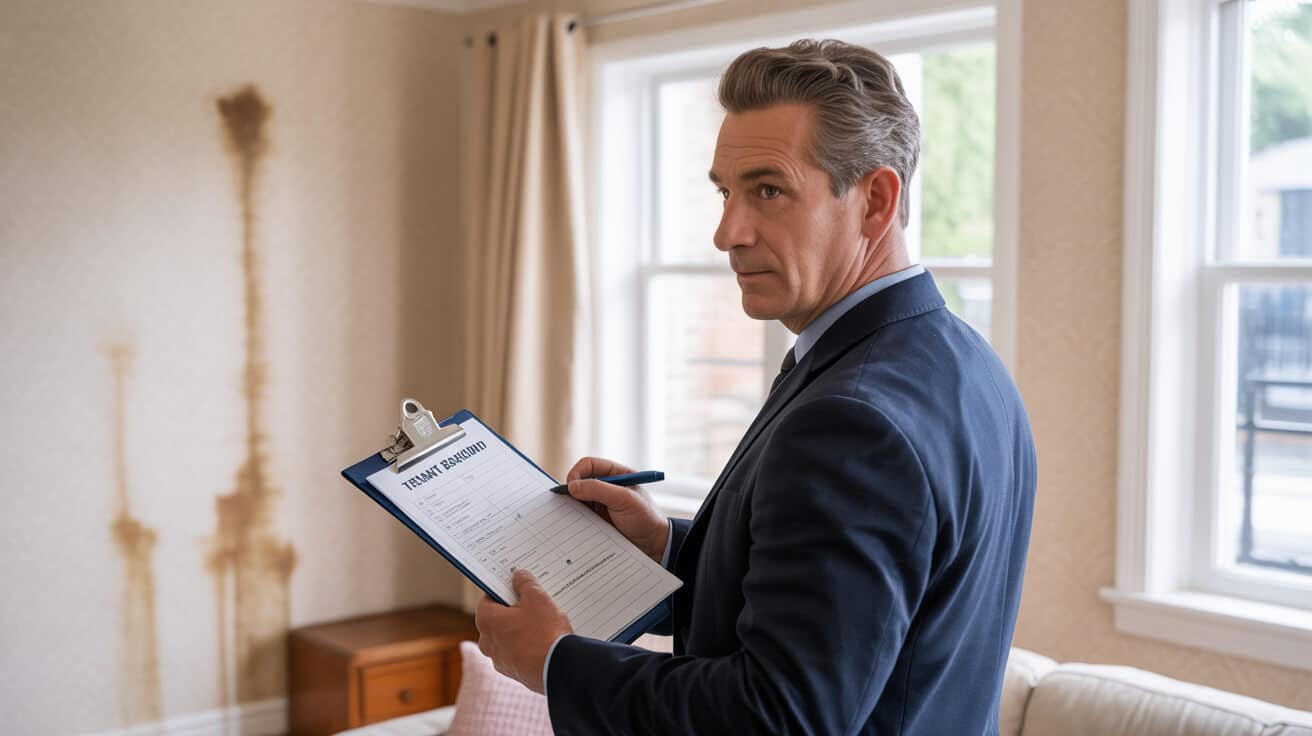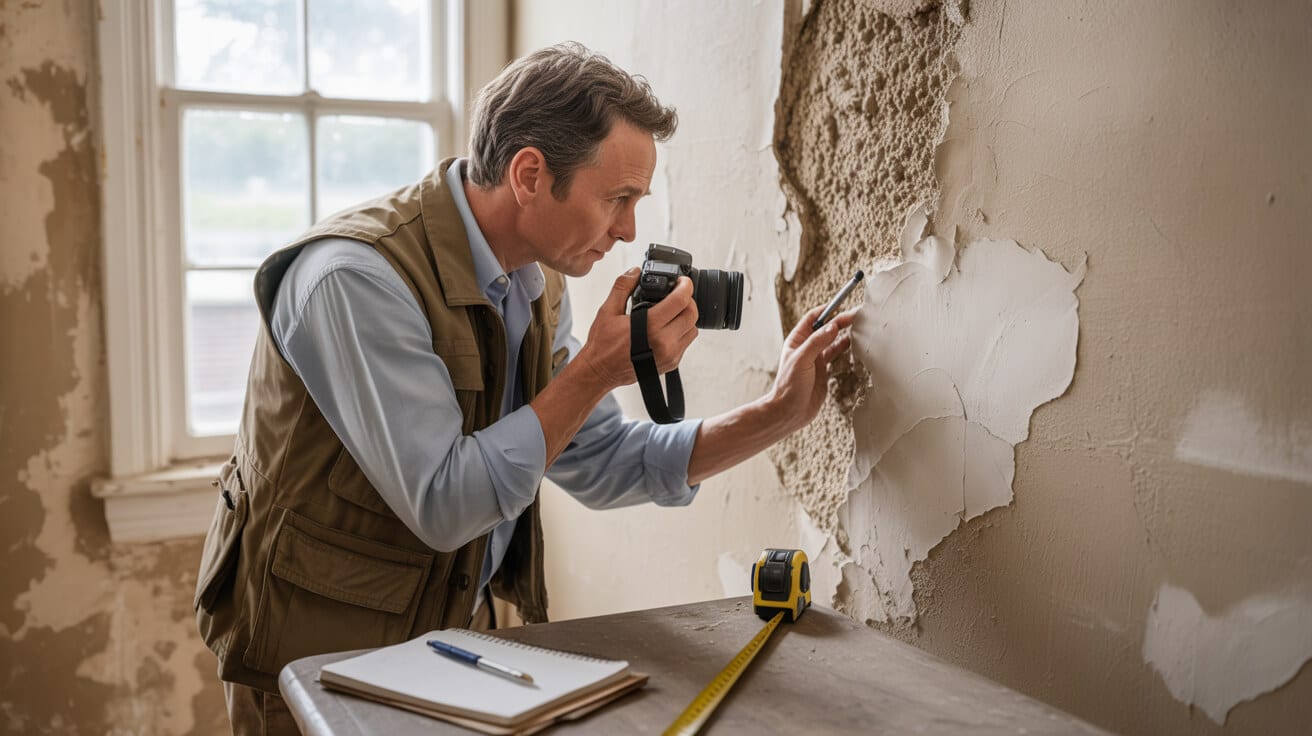 Using Repair Logs And Documentation For Tennant Deposit Deductions
Using Repair Logs And Documentation For Tennant Deposit Deductions

Does Your Evidence Really Stand Up? How Repair Logs Make or Break UK Deposit Deductions
What separates a lost deposit dispute from a victory isn’t how convinced you are—it’s how robust your proof truly is. Landlords, property managers, and facilities teams across the UK are discovering that “my word against yours” is now obsolete. The only question that matters is: does your documentation survive the microscope?
“A logbook with gaps is an invitation for deductions to be rejected.”
Regulation has shifted. With tighter housing legislation and digital adjudication, resolution is less about intent and more about the rigour of your records. Today, successful claims are built from the ground up: a methodical log of every repair, every notification, and every penny spent—linked, cross-referenced, and ready for challenge at a moment’s notice. Anything less is a liability.
What Proof Does a UK Deposit Deduction Really Require?

The law isn’t about what feels fair—it’s about what you can demonstrate. Housing Act 2004, along with all leading deposit schemes (TDS, DPS, MyDeposits), lays the burden squarely at the landlord or agent’s door. It’s not enough to suspect or remember; every deduction becomes a test of documentation.
If your claim can’t map, step by step, from tenancy start to the disputed repair, it won’t stand. Adjudicators look for more than summaries—they require a transparent, auditable storey, anchored in fact.
To justify a UK deposit deduction, you need:
- Signed, date-stamped check-in and check-out inventories, with images;
- Chronological, detailed repair logs for every cited issue;
- Receipts or invoices directly tied to the action taken;
- Full records of tenant communications—emails, signed notifications, acknowledgements.
“The landlord must prove the basis for any deduction… the onus is on them at deposit arbitration.” *(Deposit Protection Service)*
Miss a document, lose a link, and your case unravels—sometimes over a technicality. Each part forms a chain: break it, and even genuine claims risk rejection. Your records don’t just serve you—they become your legal defence.
Why Standard Inventories Aren’t Enough—And What Adjudicators Really Want

Paper inventories, spreadsheet checklists, a handful of photos—most portfolios still rely on this patchwork. But over 60% of UK deduction attempts fail for incomplete or inconsistent evidence (Propertymark, 2024). Adjudicators expect more: precision, cross-referencing, and clarity. If a file, timestamp, or reference is off, your credibility drops.
“The difference between a successful claim and a failed one is often a single missing document—don’t give an adjudicator an excuse to doubt you.”
It’s no longer about quantity but quality—joined-up audit trails are the gold standard. That means:
- Inventories and reports signed and dated, photos labelled and referenced;
- Logs with room-by-room granularity and unambiguous contractor names;
- Receipts and invoices matched line-for-line with repairs;
- Digital backup and open access, ready for inspection.
A small slip—like a photo with the wrong date, or a receipt without a reference—can collapse your case. Seasoned operators win by making every fact unassailable.
What Makes a Repair Log ‘Credible Evidence’ According to Arbitrators?

An effective repair log isn’t just a memory-jogger; it’s exhibit A in any dispute. Adjudicators assess repair documentation with forensic precision, discarding anything that isn’t specific, corroborated, and traceable.
A credible repair log contains, at minimum:
- The full date and exact property location;
- A clear description of the issue (not just “repair complete”);
- Contractor or staff name, logged per event;
- Attached, referenced visuals (photos, video) for each stage;
- The precise cost and invoice number, matched to the tenant’s unit and tenancy dates;
- Context or annotations (e.g., “urgent late-night callout”, “tenant present for inspection”) when needed.
| Date | Location | Issue | Proof | Contractor | Cost | Invoice Ref |
|---|---|---|---|---|---|---|
| 10/03/2024 | Bedroom 2 skirting | Gouged timber | Photo #12 | All S4U (M. Lee) | £28.50 | 2756-SKIRT |
| 14/03/2024 | Bath, towel rail | Loose wall plugs | Video+Img | All S4U (E. Okeke) | £12.00 | 2781-TRL |
“Specific, date-stamped, room-labelled evidence is now expected; missing logs cost landlords claims.” *(Justice for Tenants)*
Entries that read “fixed windows” or “sorted kitchen sink” get you nowhere. Adjudicators want to see the who/what/where/when/how nailed down—each data point linking seamlessly to the next.
How Should Photos and Video Evidence Be Captured for Ironclad Proof?

A hundred images mean nothing if they can’t be proven to relate to the disputed repair. In the UK, adjudicators treat media as core evidence, but only if every file can be traced clearly to a repair log and context.
“Generic or undated images are rarely accepted. Specify room, date, and item every time.” *(Deposit Protection Service)*
Essential photo and video standards:
- Every image should be dated (ideally time-stamped by device or held up on paper in-shot);
- Label property, room, date, issue in the filename—e.g., “UpperFlat_Kitchen_TapLeak_12052024.jpg”;
- Capture both “before” and “after” shots for maximum credibility;
- Refer to visuals explicitly in logs, e.g., “see Image #9 – tap before/after repair”.
How do top managers guarantee their evidence holds up?
- Always use devices with built-in metadata and backup to secure cloud storage;
- Store images in dedicated, labelled folders by property, date, and issue;
- Attach every visual asset directly to the corresponding log entry;
- Archive originals securely to prevent loss or corruption.
Treat your image like a legal document, not a decoration. A single misfiled or unlabeled image is all a tenant needs to win a claim.
How Do You Crosslink Inventories, Logs, Photos, and Communication Into a Winning Audit Trail?

Lost deposit disputes can be traced back to missing links, not missing intent. Adjudicators seek a seamless chain of evidence—a file that any outsider can connect from start to finish, with no gaps or confusion.
The building blocks of an indestructible audit trail:
- Each deduction matches a clear entry on both pre- and post-tenancy inventories;
- Every claim syncs to a granular repair log, with date and staff cross-referenced;
- Photo/video proof attached for each repair, labelled and referenced;
- Receipts or invoices that map line-for-line to jobs and costs;
- Tenant communication showing notice, requests, or sign-off—preferably signed or acknowledged in writing.
“Submit a cross-referenced bundle: inventories, logs, receipts, photos, and communication records.” *(MyDeposits)*
A system like this short-circuits disputes. When every link is watertight, tenants are less likely to contest, and adjudicators can approve claims without a second glance.
Why Most Deductions Fail—And How Systematic Logging Changes the Outcome

Most landlords and agents don’t lose claims because tenants are persuasive—they lose because their documentation can’t withstand scrutiny. The usual suspects:
- Vague job logs (“repaired window”) without dates or room references;
- Receipts missing details on the specific unit, tenant, or issue;
- Repairs invoiced without link to corresponding communication or event;
- Images with no label, timestamp, or proof of context.
“Evidence must show what was paid, to whom, and what for.” *(Shelter)*
With these gaps, even well-founded claims fall apart. The fix? Meticulous logging, immediate entry (not weeks later), every piece cross-referenced, every transaction tracked.
- Use digital maintenance software that ties every log to photos, invoices, and tenant contacts;
- Store even “routine” or “no-charge” repairs in the same system—no task should be invisible;
- When communication occurs, archive it—every text and email can become evidence.
Stop relying on memory—a written, timestamped system is your security blanket.
Should You Move to Digital? Templates and Tech That Protect Your Claims

Relying on paper or ad-hoc spreadsheets exposes you to unnecessary risk in the era of digital adjudicators. Cloud-based logging, digital photos, and templated records are affordable, efficient, and favoured in deposit scheme decisions.
Why modern digital solutions outperform old systems:
- Templates built for dispute resolution—include every mandatory detail;
- One-click photo/video upload & date-stamping for flawless cross-referencing;
- Team access and change tracking, so no data is lost and responsibilities are clear;
- Export-ready bundles for fast submission to deposit schemes or courts;
- Secure, redundant backups—no more “lost paperwork” or accidental deletions.
“Integrated platforms that sync repair logs… for transparent, shareable records.” *(Justice for Tenants)*
Whether your portfolio is five homes or five hundred, digital-first recordkeeping will protect your investments, simplify inspections, and let you respond to disputes with confidence.
Don’t wait until you lose a claim to modernise—every day without a system is a risk you don’t need.
Book All Services 4U Today: Evidence That Defends Your Investment
The secret to winning deposit disputes—and to running a truly professional portfolio—is evidence, not argument. All Services 4U puts systematic, dispute-proof documentation at your fingertips:
- Detailed inventories and inspection packs for every unit—always check-in/check-out signed, with labelled photo/video;
- Repair logs crafted to deposit scheme expectations—cross-linked to receipts, costs, and staff entries;
- Secure archiving—physical or digital—with instant export for tenancy schemes, auditors, or courts;
- Communication logs that include tenant acknowledgements, access notifications, and real-world time-stamps.
When every claim is supported step-by-step, your properties stay yours and disputes disappear.
Make documentation your competitive advantage. Download a free, ADR-ready repair log template—and put your next deposit deduction on unshakeable ground. When you’re ready for zero-fault recordkeeping, call All Services 4U and get evidence that wins.
Frequently Asked Questions
What documentation gives UK landlords unshakeable proof for deposit deductions?
Robust deposit deductions in the UK hinge on a complete, interconnected chain of documentation—each link independently verifiable and sequenced so that no part can be questioned or dismissed in dispute. You need more than just photos or a check-out note: every deduction stands or falls on the strength of your timeline, your evidence’s credibility, and the ability to show exactly how one piece flows into the next.
A single unsigned inventory or untethered invoice shifts the power to the tenant—join your documents and keep control.
Which documents carry real weight for a UK dispute?
- Signed tenancy agreement: spelling out deposit terms and tenant obligations.
- Detailed, co-signed check-in and check-out inventories: with photos, room-by-room.
- Date-stamped photographic evidence: linked to inventories.
- Repair log: for every remedial job, stating what happened, when, and who carried out the work—with professional credentials attached.
- Original invoices or receipts: showing cost and proof of professional service.
- Deposit protection certificate: from an approved scheme (DPS, TDS, MyDeposits).
- Complete correspondence trail: —all emails, texts, or notes between landlord/agent and tenant about the damage or repair.
Each piece must clearly cross-reference the others—picture captions should match inventory entries, and repair logs must cite both the photo and the relevant clause in the tenancy agreement. Without these, adjudicators routinely slash, dismiss, or reverse deductions, citing lack of a coherent evidence trail.
How does this approach stand up under challenge?
Leading deposit protection schemes confirm that joined, timestamped chains of evidence dramatically increase acceptance rates (MyDeposits, 2022). Landlords who submit unconnected items—like unlabelled photos or unsourced invoices—lose out even when damage is real, because the tribunal can’t follow the storey.
You can see more on building an evidence chain in the main article—this guide digs into each document’s role.
How do you structure repair logs so deposit schemes accept your claim without fuss?
The key to a repair log that deposit schemes and tribunals trust is precision—every entry in your log should cover the “where, what, when, who, and how,” cross-referenced to inventories, photos, and invoices. Landlords who go further—using standard logbook templates and embedding evidence within the report—find their claims processed faster and with less opposition.
Disorganised or vague logs invite scrutiny; a well-structured record quietly defuses objections before they start.
What do repair logs need to make your case bulletproof?
- Log entry date and exact time: , every time—no blank days or approximations.
- Precise property address, room, and item name: —“Bedroom 2, wardrobe door,” not just “door fix.”
- Problem description: matched to the inventory: “Scuff on wall, not present at move-in, noted at check-out.”
- Step-by-step repair diary: who did what, tools and materials, from diagnosis to sign-off.
- Trade professional details: for outside contractors—including company, trade registration, and any accreditations (e.g., Gas Safe, NICEIC).
- Before, during, and after photos: directly referenced with file names in the log.
- Attached digital invoices/receipts: —not just cost figures, but proof of payment and supplier.
- Notes of any tenant communications: regarding repairs.
A typical, tribunal-ready repair entry might read:
2023-03-07, 15:48 // 34 Rose Lane // Lounge – Window frame gouge: Recorded check-out (not at check-in). Repair by Hector Gauge, All Services 4U (NVQ3 Joinery). See IMG0334_before.jpg and IMG0461_after.jpg. Invoice #7142 attached. Tenant notified via email 2023-03-09.
Table: What weak vs. strong logs actually look like
| Weak Log | Strong, Admissible Log |
|---|---|
| “Fixed the door.” | “Bedroom 1, door off hinges—repaired 14/02/24, photos & invoice attached; itemised in entry.” |
| “Wall patched, tenant agreed.” | “Living room, wall scuff—matched to move-in photos, contractor (City & Guilds) details, check-in and check-out comparison.” |
Deposit schemes such as DPS expressly favour repair logs that reference inventory, photos, tradesperson, and invoice within the same entry (DPS Guidance, 2023).
Why will “just photos and a description” nearly always lose a disputed deduction?
A photo paired with a short description doesn’t establish a sequence, doesn’t prove when the damage happened, and does nothing to show the tenant’s responsibility or that the cost is justified. Tribunal adjudicators want to see that damage wasn’t there at the start, appeared during the tenancy, and that you communicated about it fairly and documented each repair step and cost.
When your evidence fails to show a clear before, after, and who did what—expect your claim to collapse fast.
What’s actually missing when this approach fails?
- Pre-tenancy (check-in) images: for direct comparison—without these, the tenant can argue the problem was pre-existing.
- Timeline evidence: —dates tying photos to real tenancy events.
- Links to inventory and repair log: —matching words and items.
- Proof of fair wear assessment: —a tribunal will always ask if the issue exceeds reasonable use.
- Invoices matched to each claim: —showing cost and professional repair.
For deposit protection claims, such as those run by TDS or DPS, “photo plus description” is almost always rejected if the chain isn’t complete—even a minor documentation gap can result in a rejected or drastically reduced deduction (TDS Annual Review, 2023).
The main article covers the basics; this FAQ drills down into why disconnected evidence loses cases.
Where do landlords most often undermine their own deposit deduction cases?
The most frequent sabotages happen in small details: unlabelled or unsigned inventories, repair logs lacking room or item detail, repair costs with no matching invoice or professional ID, or time lags that throw doubt on the whole sequence. DIY, informal language (“just fixed it, tenant knows”) rarely survives scrutiny—schemes want traceability and a chain that’s clear whether or not everyone was present when repairs were made.
A shortcut in record-keeping is an open invitation for the tenant’s side to win. Every gap, no matter how small, opens the door.
Mistakes that go unnoticed until the claim is lost
- Inventories not signed by both parties: (or missing dates).
- Repair notes too vague for an outsider to follow: —e.g., “dripping tap replaced.”
- Photos not anchored to inventory or log: (missing room/issue description).
- Invoices not detailed or broken down by job: —one lump receipt for multiple fixes.
- Repairs carried out by unregistered contractors: —missing credentials fuels tenant challenge.
- Delayed documentation: —logs or photos created days after the incident, opening up doubt or suspicion.
- No “fair wear and tear” assessment: recorded—leaves deductions wide open to challenge for being punitive or excessive.
A consistently missed area is the failure to keep logs in real time—if a photo appears after a repair, or an invoice has the wrong date, the case is instantly at risk.
What’s the process for building a dispute-proof bundle of evidence from your repair logs?
A dispute-proof bundle isn’t just a pile of documents; it’s a connected pack where every deduction can be checked by a third party in seconds. Start with a “case index”—a list of each deduction/issue and the supporting documents in order (inventory, photos, repair log, invoice, tenant communication, DPS registration, etc.).
Use a digital folder structure named by property, room, then issue. Each file name should make sense (“Kitchen_sink_leak_BEFORE.jpg,” “Invoice_TapReplacement_BluePlumbCo.pdf”). Every photograph, log, or receipt is referenced by name and date in your case index. Create a single PDF with hyperlinked bookmarks (or a cloud folder with links, if accepted) for digital submission.
An adjudicator sees navigable, timestamped bundles as both credible and respectful—they make your case difficult to challenge.
Building blocks of a “case bundle” that gets acceptance fast
- Bundle index sheet: Summary of all issues by location/date and supporting documents
- Issue-by-issue folders: Each claim–with inventory, cross-referenced photos, repair log, invoices, comms, compliance documents
- Digital bookmarks/hyperlinks: Make navigation effortless for reviewers
- Annotations or highlight notes: Explain context, responses, or special factors
- Exported or printable format: PDF or cloud submissions accepted by the deposit scheme
This approach is so effective that industry advisors recommend “bundle building” as essential learning for all property managers (NRLA Best Practice Guide, 2023).
Which digital tools and templates actually save time and boost deposit win rates for landlords?
Using property-specific technology isn’t “nice-to-have”—it’s the new expectation in professional property management. Cloud-based logbooks (like InventoryBase, Arthur, or Fixflo) capture events as they occur, enforce time-stamped entries, allow you to add photos from your phone, and auto-export evidence bundles at dispute time. Logbook templates—whether advanced Excel sheets, Google Forms, or DPS/NRLA checklists—ensure no required item is missed and no field left blank.
Some maintenance specialists (All Services 4U, for example) provide ready-made, scheme-friendly documentation packs containing all logs, inventory entries, before-and-after images, proof of repair, and correspondence. Mobile tenant apps now let residents upload their own check-in evidence or report fixes, automatically syncing this with your log.
Proactive tech puts your evidence in order, your compliance on show, and your stress in the rear mirror—a professional’s best asset.
Table: Digital tools for bulletproof deposit documentation
| Tool/Platform | Function | Benefit |
|---|---|---|
| InventoryBase/Fixflo | Inventory/log automation, photo uploads, export tools | Real-time capture, rapid export |
| All Services 4U packs | Fully bundled digital repair documents for upload | Audit-ready, compliance-proven |
| DPS/NRLA Templates | Field checks, standardised logs, cloud storage | Scheme-aligned, step-by-step |
| Mobile tenant apps | On-the-go inventory evidence, fix reporting | Minimises gaps, time-stamped |
Implementing a single, joined-up system that covers every link—commission to repair to communication—protects your deposit, your reputation, and your time.



